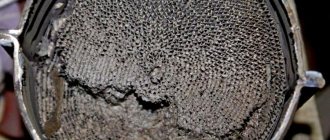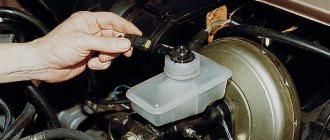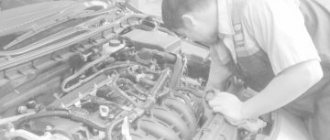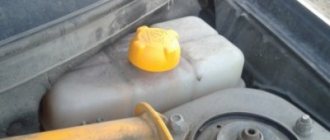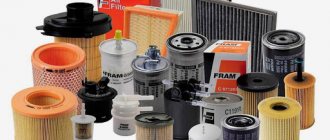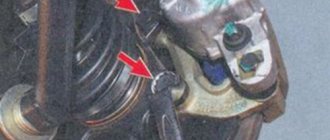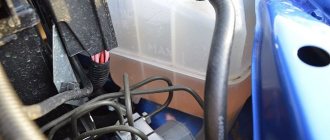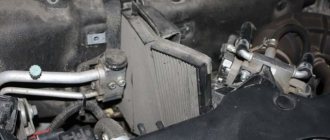On the engine front shield there is a reservoir into which the brake fluid is poured, it is very easy to find it in any front-wheel drive car, and on a classic it is essentially located in the same place, for clarity, what this reservoir looks like and what sticker is attached to it, you You can see the photo below, but only there is the tank of a VAZ 2109, on Priors it has a slightly different shape, but the sticker on it is exactly the same. In this episode of Technical Environment, its host Gennady Emelkin will talk about how to independently replace...
Take precautions when working with brake fluid: it is toxic. If brake fluid comes into contact with wires, plastic or painted body parts, they may be damaged. Therefore, when pouring, always use clean rags. If liquid gets on parts, wipe them immediately with a clean cloth. Replacing brake fluid on Grant.
The next stage is pumping out the brake fluid already in the system.
To do this, remove the rubber cap from the right rear fitting of the valve, having previously cleaned the latter from dust, dirt and carbon deposits, and instead of the cap we put on a transparent tube, which we lower into a container for working out.
Here you will need outside help, since it will not be possible to pump the brake pedal and work under the car at the same time. Replacing brake fluid and bleeding the brakes of a VAZ 2108 2110 2114 Priora in the cold with your own hands, dismantling, washing...
Ask your partner to press the brake pedal several times, and then, pressing it all the way, hold it in this state until the desired moment. At this time, another person is under the car and, using an eight key, unscrews the air release valve.
But you don’t need to unscrew it completely, just make a few turns until the used brake fluid flows out of the container. As soon as this happens, the brake pedal will fail.
The car owner should quickly tighten the valve as soon as all the old fluid is gone.
At the same time, you should inspect the entire system responsible for the brakes, since if the brake fluid leaks, this may indicate problems or the need to replace the master cylinder gasket. Brake fluid tester Proven Auto Parts (swelling, foreign car) CAR Mysteries…
In order for the brake system in a Lada Priora to function correctly, it must contain the working fluid at the proper level. What volume is required for the correct functioning of the brake system can be found in the service book attached to the machine. Replacing brake fluid on a LANCER X in 20 minutes - by two amateurs. THE BEST CHOICE was to replace the brake...
Periodically check the level of brake fluid in the reservoir and add it if necessary, otherwise air will enter the brake system. Guys, try not to add brake fluid to the brake fluid reservoir. Keep it at minimum...
Source: https://vidsp.ru/remont-avto/kak-pomenyat-tormoznuyu-zhidkost-na-lada-priora.html
Anti-lock braking system ABS: types, types
Depending on the type and type, ABS is classified into:
- One scheme of operation of the ABS system is when all the devices that make up the ABS are located in one unit. That is, the hydraulic valve block, hydraulic accumulator and pump are located in one unit.
- The second ABS scheme is when the component devices (hydraulic valve block, hydraulic accumulator and pump) are located in different places. In this type of braking system, in addition to the ABS module, there is also an ESP module and an SBC module.
Whether you can bleed the brake system yourself depends on what type of brake system is in your car.
If the car has a system of the first type, then it is easy to properly pump the ABS.
If the car has a system of the second type, then one cannot cope without a scanner; it needs to be pumped to a service center for maintenance.
The ABS system consists of:
- Sensors (installed on the hubs). When replacing rear wheel hubs, as well as some front ones, you may notice special recesses for sensors. They are engaged in transmitting data about the speed of movement.
- Control valves (installed in the brake system). Serve to change the pressure in the system.
- The electronic unit. Receives speed information from sensors and adjusts control valves.
Brief excursion
In numerous videos presented on the Internet, you can see this car, get acquainted with its characteristics and watch test drives. The spacious interior and large trunk are impressive, which is very useful for Russians - especially those who like to travel outside the city.
In 2010, Lada Largus was first presented to the public. After 2 years, the first car rolled off the assembly line and industrial production began. The car itself is a copy of the Dacia Logan MCV, presented under license for production at AvtoVAZ. Nowadays, several modifications of the Lada Largus are produced: with a station wagon body capable of accommodating 5 or 7 passengers, as well as with an all-metal body and a 2-seater saloon.
The car is equipped with two French injection engines with a volume of 1.6 liters - with 8 valves and a capacity of 87 hp. s., as well as a 16-valve engine with a capacity of 105 horses. A 16-valve engine has two camshafts, an 8-valve engine has one. The car is made on the Renaul Logan platform, and the engines are also taken from there. Transmission – manual 5-speed, French.
In the video you can see how the Lada Largus confidently moves along our roads. This became possible because the suspension, springs and shock absorbers are adapted to Russian road conditions and are designed for increased load capacity. Increased ground clearance also contributes to good cross-country ability.
What kind of engine oil should I fill in Lada Largus? It can be from different brands, but must strictly comply with the manufacturer’s specifications. The requirements for the 16-valve K4M engine are as high as possible. It is better to fill in the engine oil that is used at the factory when the car was produced.
Until recently, during the first refueling, ELF SOLARIS RNX 5W30 was poured into the engine. Before this there was LUKOIL Genesis RN 5W40. The latest official information from the manufacturer states: the first filling is carried out with ELF EXCELLIUM NF 5W40 lubricant. As you can see, in both last cases the oil characteristics are 5W40, which is what needs to be taken as the basis for further operation.
Please note that 5W30 oil is less viscous than 5W40. Renault advises refilling a 16 valve engine with ELF EVOLUTION SXR 5W40. But for an 8-valve engine, a 5W30 oil change is recommended. This is due to the fact that the more viscous 5W40 is better suited to hydraulic valve compensators. Therefore, whatever the lubricant is, it must have such characteristics.
There is no consensus among car enthusiasts regarding 16-valve engines. AvtoVAZ also does not have a clear position on this issue. Its first digit depends on the operating temperature: 0, 5, 10 or 15. For low temperatures from -30°C you need to use 0W, for moderately low temperatures (from -25°C) - 5W, etc. For all of the above cases a viscosity of 30, 40 or even 50 is required. In the presented video you can hear all the explanations why 40 or 50 cannot be poured into an engine designed for a lubricant viscosity of 30, even if it already has a good mileage.
The properties of the lubricant must comply with API SL/ API SM/ API SN. Requirements for the ash content of oil in a 16-valve engine are ASEA A1/ ASEA A2/ ASEA A3/ ASEA A5. The brands are not named, that is, you can pour in the motor oil that you subjectively like best. Now there is a new, most suitable modification on sale - ELF EVOLUTION 900 SXR 5W40. Surely it is produced with other parameters in terms of temperature and viscosity. How much lubricant should I buy? Replacement in Lada Largus requires from 4.6 to 4.8 liters of lubricant, the engine crankcase is designed for 5 liters.
ABS bleeding sequence
- First, we look for and remove the fuse in the fuse block that is responsible for the operation of the anti-lock braking system.
- Next, we jack up and remove one front wheel, and look for the brake wheel cylinder (BWC) fitting.
- After this, we put a hose on the fitting (from a hydraulic level, for example).
- Open the fitting one turn.
- One presses the brake pedal all the way and holds it in that position.
- Now turn the ignition key to turn on the hydraulic pump (the ABS indicator lights up on the instrument panel).
- The second person watches how air is removed through the hose and, after removing the air, tightens the fitting.
- We release the brake pedal only after tightening the fitting.
- Now, how do you know that all the air has escaped from the ABS? This shows the ABS icon on the dashboard, if it goes out after removing the air and tightening the fitting, then all the air has escaped.
US standard
The American Department of Transportation has created a quality standard FMVSS No. 116 (Federal Motor Vehicle Safety Standard), which it is advisable to use.
If anyone doesn’t know what DOT is in the designation of brake fluid, then it is nothing more than an abbreviation of the name in English of the US Department of Transportation, that is, Department of Transporation or DOT.
Therefore, owners of new modern cars must adhere to the accepted quality standard, that is, use glycol TJ DOT 4 or glycol-silicone DOT 5.1.
And for old cars, roughly speaking, before the year 2000, you can safely use DOT 3 or BSK.
BSK brake fluid is an old brand of TZh, which is created by combining castor oil and butyl alcohol in a 1:1 ratio. Analogs of BSK liquid: Neva, RosDot, Tom, Rosa.
Conclusion
After carrying out repair and maintenance work on critical components of the car, before driving, you must first check the tightness of the system and the operability of the vehicle components.
ABS - Anti-lock Braking System is a system against wheel locking during heavy braking. Thanks to the fact that ABS prevents the car from skidding along the road, safety increases in emergency situations. The anti-lock braking system will operate correctly if the system is not air-filled.
Watch this helpful video. Tests show that even a working ABS system turns off at the end of the braking distance, so you still need to modify it with your foot.
The manufacturer recommends replacing brake fluid on a Lada Priora car every three years of operation or every 45 thousand kilometers.
LADA > Priora
We carry out the work on an inspection ditch or overpass. Unscrew the filler cap of the tank.
Fill the reservoir with new brake fluid.
Attention! If brake fluid gets on your car's paintwork, plastic parts, or wiring, it can cause damage. Remove it immediately with a clean cloth.
It is necessary to bleed the brake system hydraulic drive until new fluid (lighter than the old one) begins to come out of the bleeder fittings of all working cylinders.
We carry out pumping to replace the fluid with the engine not running, first on one circuit, and then on the other in the following sequence:
- right rear wheel brake;
- left front wheel brake mechanism;
- left rear wheel brake;
- brake mechanism of the right front wheel.
To work you need to prepare:
- Brake fluid (recommended by the manufacturer);
- Key to "8";
- A syringe or bulb for pumping out the old brake and a piece of tube, preferably transparent (for putting on the fitting);
- Dishes for draining fuel fluid;
- Rags;
- You will also need an assistant.
A few words about safety precautions
- Be careful when handling brake fluid as it is toxic.
- Avoid contact of TJ with skin and eyes.
- Do not allow brake fluid to come into contact with plastic or rubber products or paint surfaces.
- If liquid gets on any of the above, wipe them immediately using a clean cloth.
Note : Brake fluid is hygroscopic (capable of absorbing moisture and various substances from the air), so reuse or filtering is not permitted. TJ can only be stored in a closed container.
Snapshot1
In this case, liquid will flow out of the hose. As soon as the liquid stops flowing from the hose, tighten the fitting, and only after that can the assistant release the pedal. We repeat this operation until new brake fluid (lighter than the old one) comes out of the fitting. We remove the hose, wipe the bleeder fitting dry and put a protective cap on it. Remove the protective cap from the brake bleeder fitting of the left front wheel. We put a hose on the fitting, and immerse its free end in a container partially filled with working fluid.
Changing the engine oil
Experienced car owners know that recommendations regarding oil changes should not be ignored.
Ignoring this important process provokes incredibly complex breakdowns that impede not only a comfortable trip, but also completely make such movements impossible. Used oil fluid does not provide high-quality lubrication, so parts quickly fail due to excessive friction. We recommend that you allocate funds on time to purchase oil and pour it into the engine of your favorite car.
We will tell you how to carry out such manipulations without making a single mistake, so you should not worry about your technical amateurism
We recommend that you allocate funds in time to purchase oil and pour it into the engine of your favorite car. We will tell you how to carry out such manipulations without making a single mistake, so you should not worry about your technical amateurism.
1449564308_snimok2
Similarly, we bleed the brake mechanisms of the other circuit.
When pumping, you need to monitor the fluid level in the tank and add fluid if necessary.
After bleeding the hydraulic brakes, bring the fluid level in the reservoir to normal.
In order for the brake system in a Lada Priora to function correctly, it must contain the working fluid at the proper level. What volume is required for the correct functioning of the brake system can be found in the service book attached to the machine.
If the volume of brake fluid is insufficient, this will be signaled by a specially created device and a button located in the cabin on the control panel. As soon as the red icon lights up, which shows the bends, you need to immediately add liquid.
ATTENTION! A completely simple way to reduce fuel consumption has been found! Don't believe me? An auto mechanic with 15 years of experience also didn’t believe it until he tried it. And now he saves 35,000 rubles a year on gasoline! Read more"
At the same time, you should inspect the entire system responsible for the brakes, since if the brake fluid leaks, this may indicate problems or the need to replace the master cylinder gasket.
What factors influence the need to replace the diesel fuel?
There are a number of other points that may influence the decision to replace. For example, if a driver drives a vehicle too aggressively and prefers a sporty style, then replacing the brake fluid will be required much more often.
The issue is similar with the specification and type of TJ. The better the quality of the product, the longer it will retain its technical parameters. For example, the popular brake fluid DOT 4 is designed for 50-60 thousand km.
Mechanics advise updating such a substance with the specified regularity, or after repairs have been carried out. Much depends on the operating conditions of the car. The more complex the geography, terrain and climate, the shorter the period of use of transport will be. The brake system will also wear out more intensively.
What brake fluid should I use?
The system responsible for braking the Priora can contain up to one liter of working reagent. The brake fluid should be clear with some yellowish tint. When the color of the liquid changes to dark, topping up is impossible. In this case, the substance must be replaced.
It must be said that the brake fluid in the Lada Priora system is replaced approximately every three years. This time period is considered the most optimal, since during this time the liquid will change under the influence of temperature heating. Brake fluid includes: main components up to 98% and additives. Depending on the content of the base, TJ is classified into three types:
| Type of working fluid | Compound |
| Mineral | Contains alcohol and castor oil. |
| Glycolic | Contains polyglycols and their esters. |
| Silicone | Includes organosilicon polymer products. |
In addition to these compositions, brake fluid is divided according to the degree of thickening and the temperature at which it can boil.
The Lada Priora uses DOT-4 brake fluid based on glycol. Its volume must be at least one liter. If the working fluid needs to be replaced along with the flushing procedure, then it will require more fluid - about one and a half liters.
To correctly decide which brake fluid to use, you need to carefully study whether the fluid meets the necessary requirements and GOST standards. The main ones include:
- The temperature at which heating occurs to boiling.
- Volume of least corrosive activity;
- Possibilities for lubrication.
- Stable viscosity.
Can DOT-3, DOT-4, DOT-5 or DOT-5.1 be mixed?
Differences between brake fluid classes:
- DOT 3 (glycol base) – for relatively low-speed vehicles with drum brakes or front disc brakes;
- DOT 4 (glycol base) – on modern high-speed cars with predominantly disc brakes on all wheels;
- DOT 5.1 (glycol base) - on road sports cars, where the thermal load on the brakes is significantly higher.
- DOT 5 (silicone) is practically not used on conventional vehicles.
Brake fluids DOT 3, 4, 5.1 (color from light yellow to light brown) are interchangeable, but mixing them is not recommended (it is better to completely replace them), the properties may deteriorate. DOT-5 (dark red) cannot be mixed, it only mixes with itself. In other words, brake fluids can only be mixed by color.
What brake fluid can you recommend? Is it worth changing the usual DOT-4 class for Lada to others, for example, DOT-5.1? Let us remind you that you can easily find any information about your car by its content (Niva, Priora, Kalina, Granta, Largus, Vesta, XRAY).
How to fill brake fluid correctly
According to technical recommendations, the brake fluid level in the reservoir should be checked before each trip. If it is necessary to add liquid, do so only with the product that was used previously.
Mixing different brands can negatively affect the functioning of the entire braking system. Add liquid very rarely. If it goes away too quickly, then you don’t need to top it up, but look for the reasons.
To change the fluid completely, you need to perform the following steps:
- The rear wheels should be suspended. Remove the lock from the brake force regulator for the rear brakes. Place a screwdriver or any hard object that can fit between the piston and the plate.
- Unscrew the plug from the GTZ tank.
- Using any pumping device, remove the brake fluid completely. After all this, fill the tank to the very top with new working fluid.
- Free the right rear extension of the valve from contamination, then remove the rubber cap from it. Place a hose or tube of the required size onto the appendage, and lower the free end into an unoccupied container.
- Ask your partner to press the brake pedal several times, and then, pressing it all the way, hold it in this state until the desired moment. At this time, another person is under the car and, using an eight key, unscrews the air release valve. But you don’t need to unscrew it completely, just make a few turns until the used brake fluid flows out of the container. As soon as this happens, the brake pedal will fail. The car owner should quickly tighten the valve as soon as all the old fluid is gone.
- It is necessary to carefully monitor the volume of fluid in the reservoir required for braking. It must be at a certain level. This procedure will have to be carried out until the working fluid is completely replaced with a new one.
If a Lada Priora car is equipped with an ABS brake system, then bleeding the brakes will require certain technical skills. To bleed the ABS brake system you need:
- Press the brake pedal.
- Turn off fuses.
- Unscrew the RTC fitting.
- Turn on the ignition and use a pump to remove air from the circuit.
- Tighten the fitting and release the gas pedal.
If all replacement steps were carried out correctly, the sensor light on the dashboard will go out, which signaled an insufficient amount of brake fluid. Consequently, the fluid has been completely replaced, the reservoir is filled to its maximum capacity, and the braking system (with or without ABS) is working properly.
Antifreeze quality check
You should not trust the numbers on the canister; the indicated replacement period on the packaging does not always correspond to reality. Relying on these figures, it is easy to find yourself in a situation where the antifreeze, having exhausted its service life, ceases to perform its functions. And this will inevitably lead to overheating of the power plant, although replacement is not yet necessary. But you can avoid such situations and the troubles that follow.
It is recommended to learn how to independently determine the quality of antifreeze in the cooling system and, based on this check, make a decision about replacing the fluid.
There are about ten ways to determine quality, but not all of them are available to the average car owner. At home, you can check the coolant yourself using three main methods, which are the simplest and do not require financial investment.
We check it ourselves
| Methods | Your actions |
| Test strips. | Litmus test is familiar to many people from school in chemistry lessons. They can be purchased at any auto parts store; some manufacturers offer them along with antifreeze as an addition. The test is simple: you need to dip a test strip with a reagent in antifreeze, wait five minutes and evaluate the staining result using the operating instructions. This way you can estimate the time until the next replacement. |
| Visual inspection. | Antifreeze that has lost its basic properties can be easily identified by the presence of various foreign impurities (flakes, sediment, sludge, limescale, etc.). The quality can also be judged by the color of the liquid: a cloudy color indicates the need for an early replacement. |
| Boiling. | To check quality, you can boil antifreeze. It is worth using a small amount of liquid, for example, heating a tablespoon with coolant on a gas burner or stove. If the smell of ammonia (ammonia) is clearly felt when boiling, it means the antifreeze is of low quality or it is a fake. It is better not to use such liquid. It is much more dangerous when a precipitate of copper sulfate granules forms when heated. When using such a liquid in a car, the granules will clog the cooling system channels, which will ultimately lead to overheating of the power unit. |
Knowing these simple methods, you can quickly determine the quality of the coolant at home. This way you can avoid problems with a low-quality product.
Rules for choosing coolant
The cooling system of the Lada Largus car holds 5.45 liters of antifreeze, it is recommended to purchase at least 6 liters for replacement; the remaining volume can be used for topping up during operation or if leaks occur (broken pipe, loss of radiator tightness, leakage due to weak clamps and etc.).
For the Lada Largus, the manufacturer recommends filling in Glacoel RX brand coolant; this is the antifreeze that is filled in at the factory. When choosing an alternative option, it should be taken into account that the liquid must correspond to D-class. This means that it is produced on the basis of ethylene glycol, to which a distillate, most often water, is added. As an analogue, you can use the Motul Inugel Optima Ultra brand. A similar brand is also used on Renault cars. In general, you can choose another option from a large assortment, the main thing is that it matches the basic parameters.
Question about mixing
Many motorists doubt whether it is possible to mix different antifreeze. Such questions arise due to the fact that some manufacturers use the same antifreeze (i.e., the chemical composition is identical), but compositions of different colors are used as dyes. As it were.
Mixing refrigerant of different colors, much less different brands, is not allowed.
The fact is that antifreezes with different chemical compositions, when mixed, can do more harm than good. Some car owners experiment with various refrigerants at their own risk. But repeating their actions is not recommended.
In the operating manuals of many cars and Lada Largus in particular, it is written that manufacturers of coolant for painting add a special component to the composition. But the color of the stain will depend on the specific chemical composition of the liquid. When choosing by color, it is also recommended to focus on the shade of the factory refrigerant.
Characteristics of TJ dot:
- Viscosity degree.
- Maximum temperature (boiling).
- Neutral to rubber and plastic products.
- Corrosion resistance.
- The ability to maintain its properties and qualities during long-term operation.
- Ability to act as a lubricant.
- The ability to absorb or not absorb moisture from the air.
According to the American quality standard FMVSS No. 116, brake fluids are divided into 5 classes. Some are only suitable for disc brakes, others for drum brakes.

